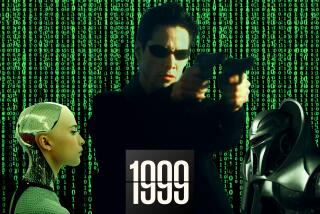The MIT Media Lab class that makes science fiction real
- Share via
A book that transmits the emotions of its story to the reader with glowing lights, sensors and actuators that can inflate a vest to cause the constriction of fear. It’s called “Sensory Fiction,” made by Felix Heibeck, Alexis Hope, Julie Legault -- and it’s just one of the projects at MIT Media Lab’s Science Fiction to Science Fabrication class.
According to its syllabus, the class “combines the analysis of classic and modern science fiction texts and films with physical fabrication or code-based interpretations of the technologies they depict.” It’s taught by Sophia Brueckner and Dan Novy.
“One might assume that there would be many science fiction fans at the Media Lab, since many future and futuristic technologies are being created here daily. And yet we found this not to be the case,” Novy told the Atlantic in September. “Science fiction is often derided as too fanciful or not rigorous in thought.”
The final projects, however, were rigorous: They were meant to create a working prototype of something related to the fiction the students had read. Nanotechnology, dystopias, cyborgs, virtual reality, wearable interfaces, retrofuturism: Make the imaginary real. As the syllabus explains, the French have a word for it: pataphysique. Pataphysics: The science of imaginary solutions.
The “Sensory Fiction” project was built around a story read in class, “The Girl Who Was Plugged In” by James Tiptree Jr.
Other projects included a robot arm like the one used to replace Luke Skywalker’s after Darth chopped his off in “Star Wars” and, from Kurt Vonnegut’s “Cat’s Cradle,” a version of Ice-9 and tools for getting it into water. Eric P., class of ‘17, blogged about the presentations.
“Before coming to the Media Lab, I was a software engineer in Silicon Valley, and what I built did indeed affect millions of people,” Brueckner, the co-instructor, told the Atlantic. “I was struck by Silicon Valley’s frenzied culture of building and launching projects as quickly as possible without considering their social impact in the long term. Unfortunately, the makers of technology are generally not encouraged to be introspective or reflect too deeply on what they are making, and this really worries me. ... Reading science fiction is like an ethics class for inventors, and engineers and designers should be trying to think like science fiction authors when they approach their own work.”
ALSO:
Jesse Ball’s slippery ‘Silence Once Begun’
Amnesia makes David Stuart MacLean a ‘Riddle’ he must solve
Bookslut launches the Daphne award: What’s the best book of 1963?
Carolyn Kellogg: Join me on Twitter, Facebook and Google+
More to Read
Sign up for our Book Club newsletter
Get the latest news, events and more from the Los Angeles Times Book Club, and help us get L.A. reading and talking.
You may occasionally receive promotional content from the Los Angeles Times.











